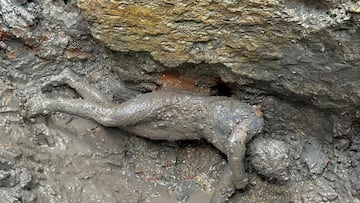Exceptional discovery in Italy that “will rewrite history”
More than 24 Roman and Etruscan statues have been recovered from the mud of an ancient bath along with numerous other artifacts in a sensational find.

More than 24 bronze statues in perfect condition and other objects, including five thousand gold, silver and bronze coins, were recovered from the mud during the excavation of the ancient Great Bath at San Casciano dei Bagni, in the central Italian province of Siena. It is being considered one of the most “exceptional” discoveries confirming yet again that “Italy is a country full of huge and unique treasures.”
“A discovery that will rewrite history and one which more than 60 experts from all over the world are already working on,” said Jacopo Tabolli, the Etruscologist in charge of the excavation. He detailed the new discoveries on which he has been working since 2019 in an interview with ANSA. In this way, it has become the largest repository of bronze statues from the Etruscan and Roman era ever discovered in Italy and one of the most important in the entire Mediterranean.
The most important finding
The general director of Italian Museums, Massimo Osanna, added that it is the “most important” finding since “the Riace Bronzes”, which were rescued from the sea. “Certainly one of the most significant discovery of bronzes ever made in the history of the ancient Mediterranean.”
Among the statues recovered from the hot mud, it is worth highlighting the presence of the effigies of Hygieia and Apollo, as well as a bronze reminiscent of the renowned Arringatore, a statue found many years ago in the Perugia area and perfectly represented the figure of the orator Aulus Metellus, an Etruscan senator during the Roman Republic.
Made by local artisans
All the statues recovered from the mud of the old baths were possibly made by local craftsmen between the 2nd century BC and the 1st century AD, a period of transition between Etruscans and Romans in ancient Tuscany.
In this sacred place, in addition to venerating the gods using these figures, people sought them out for their healing intervention in the thermal waters. In fact, the sanctuary, with its pools and sloping terraces, existed at least since the 3rd century BC, until it was closed, but not destroyed, in Christian times during the fifth century AD.
Perfect state of preservation
With all these circumstances, the statues are “all complete and in a perfect state of preservation” inside the hot springs, a fact that has allowed inscriptions to be preserved, which contain the names of powerful Etruscan families of the territory of inland Etruria. Likewise, inscriptions in Latin have been discovered, referring to the hot springs of Bagno Grande, where the statues were cast.
“This discovery is a unique opportunity to rewrite the history of ‘ancient art’ and with it the history of the passage between Etruscans and Romans in Tuscany. The sanctuary, with its statues, appears as a research laboratory on cultural diversity in antiquity, a unique testimony of Etruscan and Roman mobility”, concluded Tabolli.






